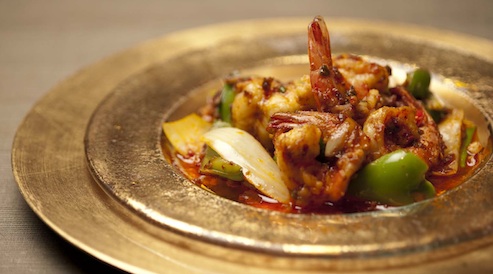
As soon as I arrived in Taipei, I dumped my bags in my hotel room and went out immediately to get a bowl of niu rou mian, beef noodle soup. My association with my favourite cities in Asia are not with its famous monuments, buildings or its history, but with the smell, the food and the people. When I slurp down a mouthful of niu rou mian with its rich, brown savoury broth and succulent beef chunks and chewy noodles, my entire being says, “Ahhh, I am now in Taiwan.” When I landed in Bangkok a few days later, all I could think about was my favourite hawker stall on Khao San Road that serves up the most delicious phad thai (stir-fried rice noodles). My mouth salivated just thinking about som yam (green papaya salad), yam plaa duk fuu (shredded catfish salad) and kaeng khiaw waan kai (green chicken curry). One of my theories about why street food in Bangkok, as well as the rest of Asia, tastes so much better than restaurant food is because of the diners’ proximity to the cook – the person preparing the dish is no more than a few feet away and the food is served steaming hot. There is no thought to plating or heightening the aesthetics of the dish, it is simply about tasty flavours that explode in your mouth. In Bangkok I led a wine and food pairing dinner at the Grand Hyatt Erawan for 70 people. The chef prepared modern Thai dishes to pair with the eight different wines I had chosen for the evening. Out of the eight wines, two were from Thailand and I was surprised to find that many people who attended the dinner, the majority of whom were Thai, had not tried either of these wines. The two wines I chose came out on top from a big tasting of over twenty Thai wines I sampled a month ago. My favourite Thai white during this tasting was the 2011 Siam Winery Monsoon Valley Colombard from Hua Hin Hills, Thailand. I’ve tasted this Colombard on many occasions and I am always impressed. The flavours are savoury and herbal with a hint of pinenuts in the background. This is one of only a handful of Thai whites with some depth of fruit and a moderately long finish. The Colombard as well as the Chenin Blanc does well in Thailand because of its crisp acidity. There is a delicate sweetness in the finish of the Colombard from the modest amount of residual sugar in the wine; it nicely balances the wine’s pomelo and lemongrass flavours. With the Colombard, the Thai pomelo and crab meat salad was perfect. The sweetness of the crab meat was heightened by the wine’s hint of sweetness while the pomelo flavours echoed back and forth from the dish to the wine glass. As a comparison, we had the 2008 Grosset Semillon-Sauvignon Blanc blend from South Australia with the same dish. By itself, this latter wine was the audience’s favourite but with the pomelo salad, most people preferred the Monsoon Valley Colombard. The other Thai wine that was served was the 2009 Granmonte Asoke Cabernet Sauvignon and Syrah blend paired with a crisp pork belly with a spicy and slightly sour sauce. The Chinese five spice aromas in the wine and its soft, rounded tannins balanced the strong sauce and paired well with the crispy skin and succulent fatty meat. This is one of my favourite reds from Thailand. I enjoy its herbal, savoury flavours as well as its notes of Chinese dried red dates and spices. I was fortunate enough to sit next to the founder and CEO of Granmonte, Visooth Lohitnavy. “We have to cope with a lot of challenging conditions besides the obvious tropical climate,” Lohitnavy confided. “We prune twice, we make sure that we do all that is possible to allow our grapes harvested in March to be healthy and ripe. But we have other challenges outside the vineyard too. Even as a local wine producer, we need to pay 260% taxes!” For imported wines, one needs to add more than 100% on top of this so wine consumption is limited to those who can afford it. Yet, wine continues to be popular and enjoyed by a growing number of wine lovers as evidenced by the dinner I hosted, which was booked out weeks ago. Pairing Thai food with wine can be intimidating because Thai food has intensity and a bright, vibrant brilliance in its flavours. Wines with equally bright fruit, sharp intensity that is balanced by firm acidity are perfect partners. The intense aromatics in the food means that aromatic whites like Riesling and reds like Pinot Noir will often work well. Reach for wines from cool climates around the world that have inherently high acidity and bright fruit and it is hard to go wrong. When in doubt, opt for one of the more affordable and well made local wines. More and more across Asia, local wine with local food is becoming an attractive alternative to imported wines.
Reprinted with permission from South China Morning Post









